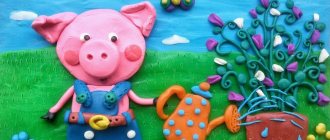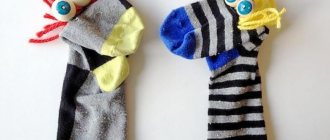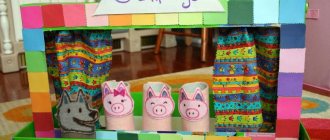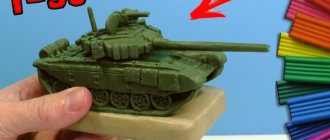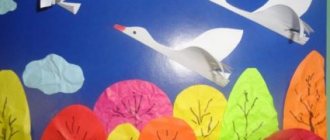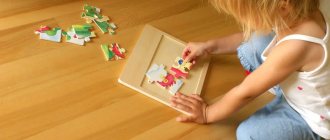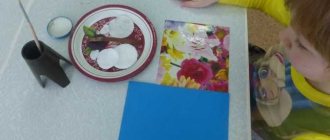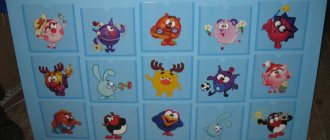Types of puppet theaters and materials
Any parent can create their own home theater. You can also involve a child in this matter. Surely in this case the process will be more fun, and the baby will be busy.
For work, something that many people will definitely have at home is suitable. Even some waste materials will come in handy, so don’t rush to scrap them.
It could be:
- Disposable plastic tableware,
- Felt,
- Boxes of different shapes and sizes,
- Colored paper/cardboard,
- Rolls of paper towels, foil or toilet paper
What types of dolls are there?
- Stationary
- On hand
- Finger
Benefits and advantages of the game
The creation of a puppet theater plays an important role in the development of children. The child not only plays with toys, but also makes doll patterns with his own hands. Then he begins to invent, like a director, in his imagination any events related to the characters. With the development of imagination, children's thinking will be much easier to perceive and assimilate new information, which will have a great impact on future studies.
Here are some advantages of such a product for preschoolers:
Stimulates the development of the child's speech and promotes the development of memory and imagination.- Excellent for developing teamwork and cooperation skills with other children.
- By independently choosing the plot, characters and lines, it will help to reveal the child’s internal problems.
- Will help the child feel more relaxed and less shy.
- Behavior skills and search for solutions are developed, which in the future will help to behave sustainably in stressful situations.
- It can be one of the forms of learning a foreign language.
- Reveals the child's musical abilities and acting talents.
- It will help you become a creatively developed person, with good abilities for self-knowledge and self-realization.
- Will allow you to get more attention from family and friends.
The kids reproduce the director's play, which allows them to relax and fully reveal themselves in the puppet show. The embarrassment and fear of public disappears, which will be very useful later in life.
Puppet theater is not only a fun pastime, but a whole technique with a learning effect, in which a child will learn to understand what good and evil are.
The emotions that kids receive from the audience in the person of their parents and educators make them feel successful. If after the performance there is a sweet reward, then the happiness of the kids will know no bounds. At the same time, self-confidence and self-confidence are formed , which contributes to the development of the child’s talents and existing skills.
Paper
Paper is one of the simplest and most accessible materials for creating crafts on the theme of puppet theater.
Staging puppet shows. Observations
- As it turned out, having the text of the roles in this form, when each character has his words in bold, it is possible to stage any performance with a script unknown in advance without preparation. This is much more convenient than the option where the author is indicated at the beginning of each replica. Everyone did a great job in their roles, even though they were seeing the text for the first time. They played like real actors and without a single rehearsal.
- As it turned out, the puppeteers held the puppets a little low. The screen for the puppet theater was quite high, the children sat on the ottoman - low, sometimes they even stood up to properly see what was happening. That is, the hand with the doll needs to be stuck out higher. I think there will be nothing terrible if the hand is slightly visible, it will be much better than children seeing only the doll’s head.
- Riddles that rhyme with wrong answers were a bit challenging for little ones. They are suitable for older children. It’s good that the characters repeated each such riddle according to the script several times, and the grandmother actively helped the kids.
- When I wrote the script for the puppet show, it seemed to me that it was very long. But in the end it turned out that it was not. If you stage such a play for older children, you can lengthen the script by one and a half times. The length was just right for our audience.
- There is no need to make decorations at all. There were a lot of people behind the screen, everyone was crawling on their knees. It was very difficult for me to move the scenery properly. In the end, the house, which was made at an angle, fell apart, people started fixing it and almost missed their “exit.”
- But overall, in my opinion, both the audience and the actors liked the performance. Adults sometimes have fun playing too.
Kosyakova Tatyana
First way
You will need:
- Paper or cardboard,
- Cereal box/desired size,
- Plastic straws,
- Wooden sticks,
- Glue,
- Scissors,
- Paints,
- Pencils.
Progress:
- On thick paper, depict the characters of the chosen fairy tale or story.
- After they are cut out, glue tubes or sticks on the inside.
- The box will act as a stage, so you will need to cut out the "screen" or one of the larger sides.
- A slot is also made in the lower part. Prepared figures of heroes on sticks should be inserted there.
Such a theater is either installed on a stand or hung around the neck thanks to a ribbon attached to the box.
How to make characters for a children's home theater?
Who will be an actor in a theater at home for children? Of course, children and you! But as an actor you will need fairy-tale characters to play with. There are three options:
- Use regular toys. But this option, oddly enough, is rejected by the children themselves.
- Make masks for yourself and your children and turn into fairy-tale characters yourself.
- Make theatrical puppets yourself. The process can turn into a fun time for the whole family.
Ideas for hand-made fairy-tale characters:
- Mitten dolls made of colored felt. These dolls fit on your hand and are ideal for a screen in a doorway. Mitten dolls are easy to make yourself. Colored ribbons and buttons are used as decoration.
- Finger puppets. They are made in the same way as mitten characters (can be knitted from yarn), only in smaller sizes, as they are put on the fingers.
- Paper dolls. You can buy ready-made sets in the store or print them from the Internet. For stability, such characters are glued to matchboxes or small plastic cups. Recommended for tabletop children's theater.
- Volumetric dolls. They are made from plasticine, salt dough, papier-mâché, and can be combined with fabric. It will take time to make them, but they will be the most expressive and interesting characters.
You can read more about making dolls here: https://portalrebenka.com/detskaya-komnata/masterim-domashnij-kukolnyj-teatr-svoimi-rukami-ot-a-do-ya.html
Or here: https://www.maam.ru/detskijsad/kukolnyi-teatr-svoimi-rukami-ochen-prosto-i-bystro.html
Second way
As a base for the characters' bodies, either homemade paper tubes or ready-made paper towels or toilet paper are used.
Depending on whether the doll will fit on your hand or on your finger, the size itself is selected. The scene is also made out of the box, as in the previous version.
This craft can be made for kindergarten or for some event.
How to make a screen for a children's home theater?
Are you planning to build a children's theater with your own hands? Start by making a screen. If there is a screen, then this is not just an ordinary game of mother-daughter or toy cars, this is THEATER.
Screen ideas for home theater:
- Doorway screen. We fasten a rope in the door, hang a canvas, decorate it, you can cut out a window or work on top. For decoration, any available material is used: scraps, remnants of ribbons, buttons, old jewelry, mother’s beads, older sister’s hairpins... Such a screen is easy to remove, and when stored it does not take up much space. And one more secret: the screen can be pulled not only in the doorway, but also between chairs, table legs or any other furniture.
- Fiberboard screen. We make a sketch with the whole family: the screen can look simple, like a partition, or like a house, or like a palace. It all depends on your imagination. At the manufacturing stage, dad and (or) grandpa are in charge (they will have to use the tool), let mom and (or) grandma help decorate (sew curtains, decorate, make it more fun). Such a screen can be of different sizes, including for a tabletop theater.
- Cardboard screen. The principle is the same as when working with chipboard. Just use thick cardboard, and make additional parts (curtains) from lightweight materials. Keep in mind that you will need space for storage or you can not disassemble the screen at all, but reserve its own place in the room for it.
- Screen out of the box. If you've recently made large purchases, don't rush to throw away the packaging box. This is an almost finished screen that needs to be decorated and (or) painted. You can use almost anything: fabric, ribbons, beads, pencils, felt-tip pens.
You can see how screens for home theaters for children are made on many websites. For example, here: https://portalrebenka.com/detskaya-komnata/masterim-domashnij-kukolnyj-teatr-svoimi-rukami-ot-a-do-ya.html
Examples of beautiful screens here: https://ihappymama.ru/domashnij-teatr-zachem-on-nuzhen-i-kak-organizovat/
Felt finger puppets
Here we will talk about felt crafts for elementary school on the theme of theater. This dense material will allow you to create many detailed and at the same time simple dolls. They are usually the right size for a finger theater.
To make them you will need:
- Felt in several colors
- Threads, needle,
- Scissors,
- Glue,
- Paper and cardboard.
Simple ideas for children's home theater
We often hear from parents that children, after visiting interactive performances at the Baby Theater, ask to play in the theater at home.
“Why not help your parents?” - we thought, and decided to collect interesting ideas on how to make a children's theater on our own. Who are these great ideas for?
Firstly, for those who have already visited our theater, participated in an interactive production and imagine what it is - a children's theater.
Secondly, for those who love to fantasize, adore improvisation, love games and fairy tales.
Thirdly, this is a great option to keep kids occupied when the weather is bad outside and you have to stay at home.
Fourthly, for those who no longer know what entertainment to offer their fidgets.
Is this home theater necessary?
It's up to you to decide, of course. But we often hear from our viewers that they love playing theater at home. And the whole family often participates in the performance. Therefore, we conclude that home children's theater:
- Favorite pastime when the whole family is together.
- Unites the family in a single hobby, including in the manufacture of props.
- Promotes children's development: staging speech, stimulating fantasy and imagination.
- This is a kind of game for attention, memory, dexterity.
- Instills in children an understanding of theater and art from an early age.
- Distracts the whole family from watching TV.
- It is a good way to distract fidgets from petty pranks.
Option with puppets
- To do this, you need to prepare a sketch in advance. There should be several elements: a large main part, hair, clothes, handles, and for animals - a muzzle.
- The next stage is transferring the pattern onto felt. Colors can be chosen to suit your taste or the child's wishes. So in photos of various theater-themed crafts you can often see pink bunnies or multi-colored cats.
- Next, once all the parts are cut out, it is better to carry out a test assembly. Thanks to this, it will be possible to correct possible errors or remove inaccuracies in a timely manner.
- The final assembly of the character should begin with the main part, adding other elements to it. You can fasten them either by sewing or using a glue gun.
Decoration and background
- Prepare in advance a diagram according to which the scene will be created in the future.
- The cut out elements are sewn onto the front side of a thick sheet of A4 felt.
- The next step is to sew together 2 sheets: a blank with decor and a felt backdrop.
- Cardboard is inserted between two fabric sheets for compaction. It should protrude a few centimeters. This strip is folded to form a stand.
Shadow play
One of the famous and interesting types of puppet theater. The main focus is on the silhouettes of the dolls, so the main challenge is to make the characters recognizable through their outlines.
A short master class on creating crafts related to shadow theater will help you organize an exciting performance at home.
Work in the theater corner
Activities related to theatrical performances in kindergarten are implemented by several types of play activities:
- Director's games. In them, the child only leads the doll, conveying the image of the character with intonation and some other techniques. The possibilities of pantomime here are also very limited, because the toy is almost static (puppets on canes, puppets).
- Dramatizations. The baby plays the role himself, without resorting to the mediation of dolls. The young actor is able to actively use intonation, facial expressions, movements and gestures to enter into the character of the hero.
- Dramatizations with bibabo, finger, floor or scarf puppets. The baby acts for the character, giving him his voice. The work is carried out from behind a screen or with a character in hand.
Working with floor dolls is very difficult, but exciting for children - you cannot use facial expressions
- Improvisation. Children act out themes, not plots. Such theatrical activity requires almost no preparatory work, but is the most complex type of game. Various theatrical props can be used for improvisation.
The theater corner, which has everything necessary for the relevant activity, allows you to create a comfortable environment in the group for the development of the creative abilities of students. Theatricalization is a special area of the educational program for preschool institutions, because it gives children the opportunity not only to explore the world around them, but also to learn to live in harmony with it. In addition, theatrical performances help children become more self-confident, which is also important for their personal growth - which means that a kindergarten cannot be without a theater corner.
Stage 1. Scene
Materials:
- Medium size box
- Ruler,
- Scissors,
- Pencil,
- Paper,
- Glue or stapler
- You need to get a large rectangle from the box. One of the main sides should be without folds. The outline of the screen is drawn on it, with an indentation of five centimeters from the edges. The resulting rectangle is cut out.
- The size of the paper sheet should be larger than the resulting hole. The screen is glued on the back side. Additionally, it is secured with a stapler for strength.
Stage 2. Heroes
Necessary:
- Pencil,
- Cardboard,
- Scissors,
- Glue or stapler,
- Straws,
- Tubes or wooden sticks
1. The silhouettes of the characters are transferred to cardboard and then cut out along the contour. They must be recognizable, with characteristic features or shapes. The scenery is created in the same way.
2. The cut out elements are attached to sticks with glue or a stapler.
Non-standard theater
In addition to standard and popular children's crafts, you can arrange your own performance using non-standard materials.
An original solution would be disposable utensils made of plastic or wood, in particular spoons. Selected characters are pasted or drawn on them, and decorated as desired. By the way, it is better to use acrylic paints for painting.
Yogurt jars, as well as plastic bottles of interesting and unusual shapes. They, like dishes, can be painted or covered with colored paper. In addition, you can make mini-scenes with decorations from bottles and arrange small stories there.
Here's an idea: it couldn't be simpler
For the theater you will not need complex props, except for:
- Building materials for decorations: cubes, pyramids.
- Fairy-tale characters, let them be familiar toys: plush animals, rubber squeakers, small dolls.
This home theater option is ideal for the youngest children. Build houses, a garage, a bus stop together with your child. And start playing and improvising. You can start with the easiest fairy tales: the bun, the turnip, the teremok. Then invite the child to add characters himself, change the situation.
For children over three years old, you can make a tabletop theater in the same way. To do this, cover the table with whatman paper and draw paths with your child. Use small characters (for example, a lot of them can be found in Kinder Surprises), use Legos, small construction sets, and small cubes for construction.
Also try making a screen to make your home theater look more like a real one.
DIY scene
To fully understand how to make a full-fledged theater-themed craft, all that remains is to create a stage. It is an important part of the production because it is where the action takes place.
- The simplest and fastest option is a plain fabric used to cover the doorway. A horizontal cut is made in the center for the dolls.
- The next simple way to build a home stage is to place two chairs with their backs facing each other and cover them with fabric.
Previously, the option of using cardboard boxes was considered. It is time consuming and requires more effort, but the results are definitely worth it.
- A frame is formed from several boxes by laying them out like bricks.
- There should be a window in the center, which will be curtained with fabric.
- For the background, all the folding parts and 2 walls of one of the boxes are cut off. A rectangle is cut out at its bottom.
- The walls are fixed in a certain way, in an angular position. This is done specifically for stability.
- Small cylinders are fixed at the folds. They will not allow the structure to develop during the presentation process.
- When the base is ready, it's time to add decorations.
